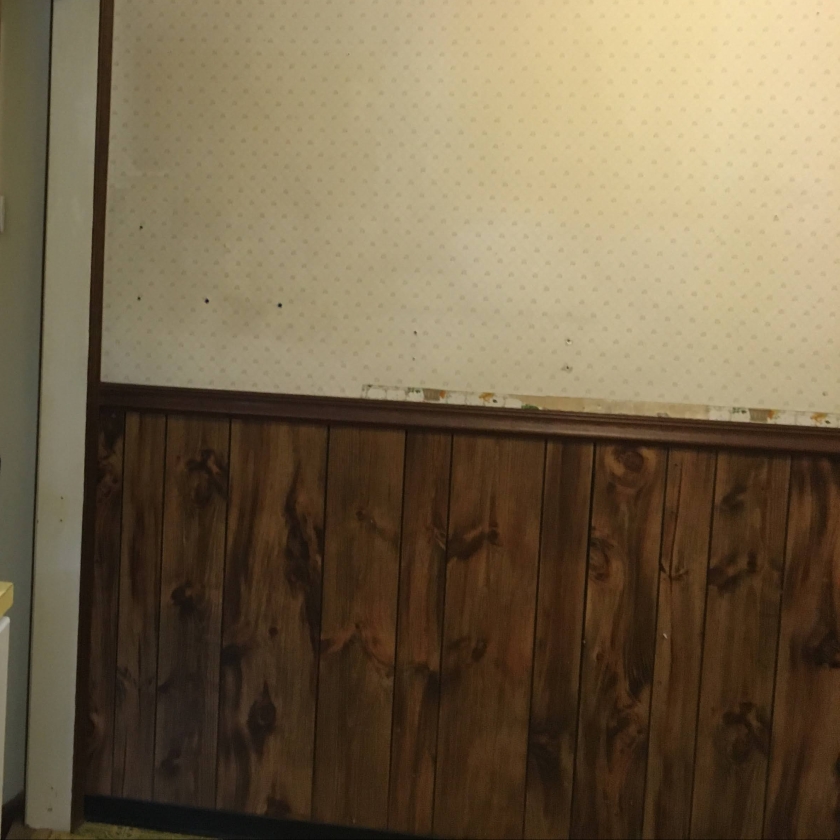Although we felt like we mostly “solved” the refrigerator issue, some additional updates were necessary (primarily to the wiring[*] but we needed a plumbing line, too). Underneath the old fridge hid another mess: the old fridge leaked then cooked water onto our avocado linoleum, making it looked like fruit gone to rot.[†] Behind the fridge lurked yellowing plaster walls, gobbed with fossilized glue[‡] that abruptly gave way to the brick backsplash. There was some good news, though. With the warmer days and strict quarantine ending, we could throw open the windows and invite the contractors in to install the new floors, pipes, and wires.

Another Change in Plans, or, as My Spouse Calls It, Project Creep
Realizing we had a month before the refrigerator delivery, my spouse uncharacteristically suggested that we paint the walls—meaning we would be free of (most of) the clashing wall décor.[§] Before he could change his mind, I set to work peeling off the layers of old wallpaper. Matters took a turn for the worse, however, when he pulled down the paneling. In addition to even thicker layers of old wall glue, we discovered crumbling plaster surrounding an actual hole in the wall—remnants of a past flood—and another problem for us to solve.


Drafting
When it comes to home construction in general and do-it-yourself (DIY) projects in particular, all budgets, plans and timelines are viable—that is, until you open a wall and make discoveries. Similar surprises abound during the writing process. Whether you have a detailed outline or a rough mental sketch about what you want to write, pre-writing planning represents a great beginning that’s likely to include some changes (possibly, many) during the drafting process.
Early drafts, particularly the first, exist to get the ideas on the page. For this reason, they are great places to experiment with a story, whether it’s adding or subtracting different elements. Drafting, too, is where writers find various problems in the narrative. In my latest story, I ultimately cut a driving scene when I realized the story really began when the main character arrived at their destination. Regardless of how long I spent writing it, the unnecessary exposition could lose my reader’s attention. And while no one is happy to find flaws in their home’s structure or their tales, the goal is improvement. As such, drafting is an important part of the writing process.
Filling in the Finish
In the end, we replaced the damaged drywall.[**] Between contractors, we painted the walls and cheered when the new refrigerator finally arrived.[††] My spouse also surprised me with a great solution for the empty space where a fridge no longer resided: using his pandemic-acquired carpentry skills, he and a friend would build a much-needed pantry cabinet. But, for now, we were done and could admire our handiwork.


What to Do with a Void
So, how does a story end? What gaps are left? For my kitchen, it was straightforward: what would we do with the area where the old fridge once lived? Another project is in the offing (yay, pantry), but we’re loving our better looking, more functional kitchen right now. For writing, drafting is usually followed by many readthroughs and edits before the work is ready to be shared with the world. My current projects aren’t quite there yet, but I’m looking forward to completing them. In the meantime, it’s back to drafting.
Happy writing, all!
TL;DR: Replacing my broken refrigerator led to changing the kitchen layout, the floors, and repainting. Parallels to writing exist. Have a read—you’ll see what I mean.
NOTES:
[*]Because celebrating Christmas needn’t involve half the house’s lights shutting off when we run the dishwasher while the oven and microwave are also in use. Since the circa 195o wiring tends to get overloaded by modern appliances, the electrician (per code) put each on their own circuit.
[†] Theoretically, that spot might’ve scrubbed off—but no one liked the floor enough to save it.
[‡] Our original walling was a laminate similar to the one seen here.
[§] My spouse likes projects to have specific, limited goals to avoid project creep, while I prefer to get everything done. But neither of us wanted to sort out the built-in cabinetry during a pandemic, so we skipped doing anything near them to avoid more unplanned projects. Looks likes we’ll be living with that faux brick backsplash a bit longer!
[**] My asthmatic lungs nixed the sanding/patching approach, which tends to be time consuming when you’ve loads of material to sand away.
[††] And we only had to rip off the door trim to get it into the room! Pro tip: never trust the manufacturer’s dimensions and measure the actual unit—unless there’s a pandemic preventing you from doing so!


